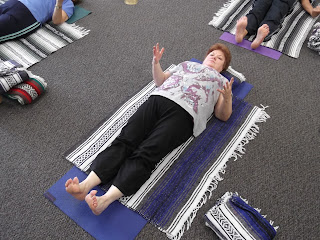A question about AHIMSA was posted by one of my students:
Thank you for the article, non harming. I've been struggling
with trying to understand why some people feel the need to be cruel and
tell untruths about others. What do they get from this intentional
hurt of others, it must feed a need they have or they wouldn't continue
to do it, right? I keep going back to a saying I have "You can't
control how others act, you can only control how you react!" But
sometimes it's so hard not to react negatively. (Question posted by Jan, a Senior's Class student)
One of the hardest things in life to really understand is why people are cruel. It's a question I've spent a lot of time struggling with, too. It's especially difficult if we are consciously trying to be kind and compassionate towards others. Compassion originates from an open heart. If we have an open heart, we have chosen to become more God-like. Yoga is a spiritual path. Because of our ongoing spiritual work, our sensitivity to the needs and feelings of others will be pretty high. Our feelings can be hurt deeply by cruelty in any form, but especially when cruelty is directed at ourselves.
 |
| Compassion towards others |
The psycho-babble reason should be reviewed. Cruelty is usually caused by a series of circumstances in early childhood. It is well-documented that a child who doesn't receive the love and nurturing in infancy and early childhood becomes emotionally underdeveloped and unable to fully mature and realize his full potential as an adult.
The child, who desperately needs love and attention from his parents, family, and significant others in his environment, was not given the love and emotional support he needed. The result was he didn't thrive. He got "stuck" in an emotionally underdeveloped stage. He perceives the unfulfilled need for love as rejection. This rejection results in a feeling of powerlessness. This feeling of indadequacy leads to bitterness and a driving need to feel powerful. He displaces his bitterness towards those who should have loved him to others by being cruel to them.
Yes, he does "get something from being cruel". His behavior makes him feel more powerful and in control. But consider, this individual is suffering. He is a product of many years of suffering.
There is a spiritual way of looking at this dilemma. Early on the circumstances and experiences he had as a child disconnected him from his very soul. He shut down his loving-kindness because it wasn't returned. This process of shutting out the soul results in mental density. The mind and therefore the individual, is no longer open and fluid. He becomes rigid, inflexible, bitter.
When the soul enters the body, it is very close to God. The infant's soul has just left the presence of God. If we stay connected to our souls, and are in an active and connected relationship with God, we understand that we are all one.
Therefore, consider being compassionate towards those who cruel. They are suffering. If we can see it that way, it is easier to not take negative judgments towards ourselves personally. We always have a choice. We can choose not to own someone else's cruel behavior. If the situation pushes us past our limits, stand up for yourself, just stand up for yourself with an attitude that comes from the heart.




















